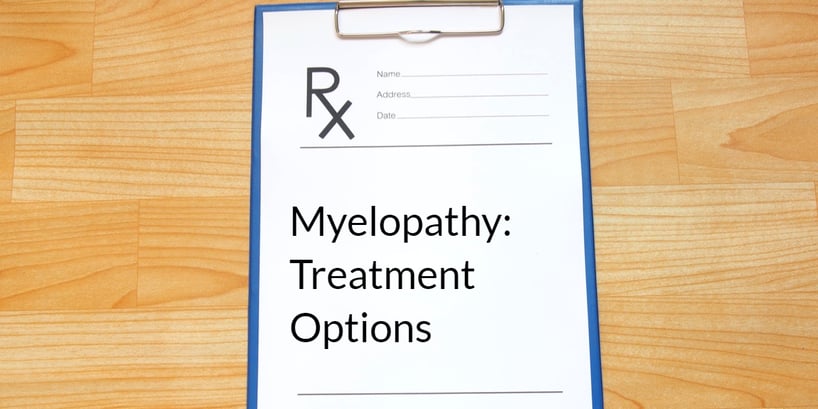

Myelopathy is a term that describes a specific condition: an abnormal compression of the spinal cord, which results in the interruption of the normal flow of nerve signals through the pinched area. The compression causes pain, numbness, loss of sensation, and difficulty with balance and movement, among many other potential symptoms.
Myelopathy most commonly occurs in people over the age of 50, both men and women, and generally develops over time as a result of natural aging processes.
Strictly speaking, this condition is not an illness, injury, or a disease. Any individual diagnosis of myelopathy must include—necessarily—both an examination of what body part is pressing on the spinal cord and an evaluation of what has caused this body part to move out of place.
What Causes Myelopathy?
Generally speaking, severe pressure on the spinal cord will cause myelopathy. The spinal cord is the body’s primary conduit for sending nerve signals to and from the brain. It is a thick bundle or neurons, or nerve cells, connected directly to the brain stem.
The spinal cord is protected by a stacked column of 33 bones (vertebrae, which provide structural strength and stability), alternating with 25 discs—thick pads of connective tissue that which provide flexibility and shock absorption. Should any of these dozens of spinal components become misaligned, they may wind up pressing upon the spine, the very organ they are designed to protect.
So what causes a disc or vertebra to become damaged enough to slip out of line and to compress the spinal cord? The most common causes are as follows:
- Normal Aging. As we age, there is a natural loss of water from inside our discs, as well as normal “wear and tear” on all of our joints, including all the tiny facet joins inside our vertebrae. This natural age-related
degeneration is known as spondylitis. It is the most common cause of herniated discs (aka slipped discs, ruptured discs, torn discs, etc.).
- Injury/Trauma. A blow to the back, including sports injuries, falls, or even an accidental hard bump into a doorknob, may cause bone fractures and disc ruptures.
- Bone spurs. Various conditions may cause unwanted chunks of bone to sprout from a vertebra and into the spinal canal, where these bone spurs may touch the spinal cord.
Additional causes of undesirable spinal compression include:
- Cancerous growths, for example bone cancers and spinal tumors.
- Inflammation within the spinal column. Inflamed tissues swell and heat due to the increased blood flow and immune system activity they cause. Autoimmune diseases (such as multiple sclerosis) and rheumatoid arthritis are examples of inflammation-sourced myelopathy.
- Infections. Similarly to the body’s inflammatory response, the immune response also increases blood flow to affected areas. Should an infection take hold in the spinal cord or the membranes surrounding it, the resultant swelling may cause compression on the cord.
- Herniations. A hernia is, medically speaking, the leaking of one tissue through its surrounding membrane into the surrounding tissue.
- Cysts. A cyst is a fluid-filled bump that generally develops in response to friction, infection, or clogging of a gland. Cysts may develop anywhere in the body, including within the spinal column.
- Hematomas. Fundamentally, a hematoma is a bruise, but it can form anywhere in the body. Medically speaking a hematoma is the result of a blood vessel rupturing (due to injury or decay) and leaking into the surrounding tissue, resulting in swelling.
- Genetic predisposition. Sometimes, people simply inherit a likelihood of developing myelopathy.
What Are the Symptoms of Myelopathy?
Every person suffering from myelopathy will feel the following symptoms:
- Pain or discomfort
- Loss of sensation, function, or movement
- Tingling, prickling, or numbness, along with feelings of being “shocked” or “electrified”
- Difficulties with balance and movement, both fine and gross (for example, writing and walking)
- Reflexes that are increased, exaggerated, or otherwise abnormal
- Movements that are sudden, spasmodic, and irregular
In addition, depending on where the spinal cord is being compressed, additional symptoms may appear.
In cervical/neck myelopathy, the compression point will be located within the first five vertebrae of the spine, just below the skull. Cervical myelopathy is the most common type of myelopathy and features the following issues:
- Pain, tingling, numbness or weakness in the neck, shoulders, and arms
- Difficulty with fine motor skills, such as writing or buttoning a shirt
- Difficulty turning the head or bending the neck
- Lightheadedness
- Difficulties with hand-eye coordination
In thoracic or chest/upper back myelopathy, additional characteristic symptoms include:
- Difficulty walking and balancing on two feet
- Weakened legs
- A sense of having abnormally heavy legs
- Loss of ability to move quickly
- Loss of urinary or bowel control
- Changes in sexual functioning
myelopathy treatment options
The fundamental goals of myelopathy treatments are to reduce pain and improve the patient’s ability to carry on with their normal, day-to-day living.
Medical professionals generally advise starting with a conservative, non-surgical approach to treating myelopathy. This strategy is supported by the collective history of invasive spinal surgeries, which may indeed provide complete relief from the pain and discomfort of myelopathy, but may also yield mixed results, have no significant effect, or even leave the patient worse off than they were.
Non-Surgical Treatment Options for Myelopathy
Conservative, non-surgical medical treatments for myelopathy may prove just as effective as surgery in helping patients to reduce pain, minimize discomfort, and ease symptoms.
Ideally, these treatments will prove effective enough to eliminate the need for an invasive surgical procedure, or at least delay it until it is proven absolutely necessary for the patient.
These types of non-surgical treatments should prove quite effective when the cause of the myelopathy is some type of swelling or inflammation in the spinal canal, or related to posture.
Painkillers. Mild cases of myelopathy may respond adequately to a strategy of pain management. Over-the-counter (OTC) painkillers such as acetaminophen are proven effective for this strategy. For more advanced cases prescription painkillers may be obtained from a medical professional.
NSAIDS. For patients with myelopathy caused by inflammation, the use of non-steroidal anti-inflammatory drugs (NSAIDs) is an excellent choice. Over the counter (OTC) forms of ibuprofen and naproxen are widely available without a prescription.
Steroid Injections. In some cases, swelling around the spinal cord may be treated with an injection of a corticosteroid, such as cortisone, directly into the epidural space within the spine. Note that such injections may take days to take effect, and may only be used sparingly.
Physical Therapy. For some patients, poor posture may be an important contributor to their myelopathy. This may result in the weakening of back and neck muscles, permitting the spine to “slump” and make it more prone to the spinal cord compression of the condition.
- The use of physical therapy to strengthen those muscles may effectively pull the spine straighter, relieving the pressure and easing the symptoms.
- For some patients with neck/cervical myelopathy, simply immobilizing the neck for a few days or weeks in a surgical collar may provide significant relief.
- A physical therapist may also assist in teaching someone suffering from myelopathy how to modify their activity, helping them to avoid motions, postures, and positions that trigger the discomfort and pain of spinal compression.
Surgical Treatment Options for Myelopathy
For people suffering from moderate to severe myelopathy, if symptoms do not improve after four to six weeks of non-surgical treatment options, or if these symptoms get worse even with treatment, surgery may be the best solution available.
In order for an orthopedic doctor to determine the most appropriate treatment or procedure to use, the following information about the cause of the pressure must be identified:
- the location of the pressure on the spinal cord (the neck is the most common location)
- the body part or object actually touching the spinal cord (most commonly a damaged vertebrae or disc)
- the cause of that body part or object having moved, grown, or distorted, enough to compress the spinal cord (degeneration or impact injury)
Surgeries designed to alleviate myelopathy will eliminate the pressure on the spinal cord, while also opening up more space for the spinal cord within the spinal canal.
Surgeries for myelopathy include:
- Anterior Cervical Discectomy and Fusion (ACDF). In this most common of neck surgeries, the entire damaged disc is removed through the front, or anterior, or the neck. The two vertebrae are then surgically fused to ensure the spine remains stable afterwards.
- Posterior Cervical Decompression/Microdiscectomy. When only part of a disc requires removal and no spinal fusion is required, it is possible to perform the surgery through the back, or posterior, of the neck. This is only recommended if the damaged portion of the disc lies too close to the spinal cord, which runs through the back of the neck.
- Posterior Cervical Foraminotomy. If the gap through with the spinal column passes (the foramen) becomes narrowed, either via a herniated disc or development of a bone spur, it may be possible for a surgeon to go through the back of the neck to remove part of the affected disc or break off the abnormal bit of bone. This procedure puts the spinal cord at some risk, but avoids the need to perform any spinal fusion.
- Spinal Decompression. In some cases where the spinal cord itself is being compressed by bone spurs or swelling (a condition known as spinal stenosis), the orthopedic surgeon has the option of removing parts of—or the entire— vertebra to relieve the problem.
- Anterior Cervical Corpectomy surgery removes at least one vertebral body (the bone at the front of a vertebra) plus the discs immediate above and below the affected vertebra bone. The bones will then be fused into one solid segment, using either a bone graft or installation of a cage.
- Posterior Cervical Laminectomy surgery takes out a back part of a vertebra, called the lamina. This procedure potentially allows you to keep more of your normal neck flexibility, unless a spinal fusion procedure is also required.
- Posterior Cervical Laminoplasty surgery cuts an affected lamina rather than removing it, and performs some restructuring of the bone to open up more space in the spinal canal.
To learn more about your treatment options for myelopathy, contact Coastal Orthopedics in Corpus Christi, Texas at (361) 994-1166 today!
Article written by: Rob Williams, MD
Dr. Williams has been practicing orthopedic surgery in Corpus Christi since 1998. After graduating from Texas Tech hereceived his medical degree from the University of Texas at San Antonio. At the prestigious Campbell Clinic located at the University of Tennessee, Dr. Williams completed not only an Orthopedic Surgery Residency, but an additional year of Fellowship Training in Spine Surgery. Dr. Williams is dedicated to creating an excellent patient experience in the office or in the surgery suite.
Topics:

